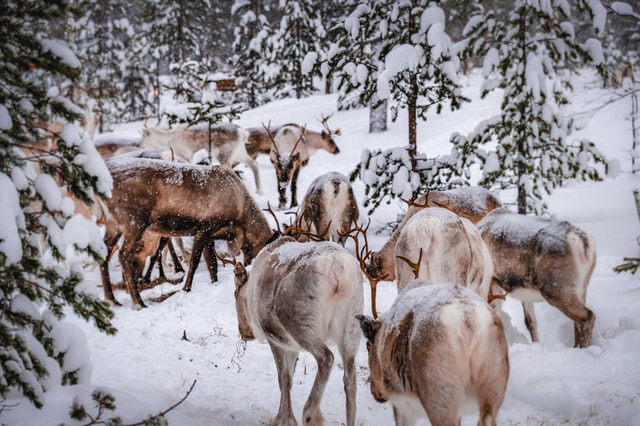Erratic weather is testing ancient relationships with the natural world
The efforts of Finland’s Sámi people to modify reindeer herding for a warming climate show the cultural hurdles climate adaptation must face.
T
he Sámi reindeer herders of Finland are starting to adapt to climate change – but there are fears that this adaptation may be hindering transmission of their traditional culture, highlighting a dilemma faced by indigenous people around the world.
A new study, which interviewed 72 Sámi people in 13 Finnish reindeer cooperatives, found that many believed shifts in animal husbandry necessary to adapt to the Arctic’s warming climate could be eroding Sámi culture.
“Some of the informants have said that if adaptation continues and more traditions are lost, is there Sámi reindeer herding culture anymore or is it just a livelihood or profession?” Klemetti Nakkalajarvi, one of the report’s researchers, told Eye on the Arctic.
One example cited was the uptake in supplementary feeding, following milder winters with higher rainfall that often cause a layer of impenetrable ice to form over ground lichen, the reindeer’s principal food. This has disrupted the centuries-old relationship between herder and animal, including long-established grazing cycles – which amounts to a kind of violent culture change.
“The next generation learns only the reindeer work model that uses supplementary nutrition,” Nakkalajarvi said. “So climate change as such does not interrupt the cultural transmission, but since the culture changes due to adaptation measures, also the cultural tradition, skills and language passed on to one generation to the next change. So traditional knowledge becomes thinner.”
Close to nature
Indigenous people – who represent over 6% of the world population and whose lands occupy a quarter of its surface – are uniquely vulnerable to the effects of climate change. Living in close interdependency with the natural world, their livelihoods are now under growing pressure as weather systems become more erratic; they currently account for 15% of the global poor.
This is also having a profound impact on indigenous culture, of which there are numerous examples. The Nenets reindeer herders, in northern Russia, are finding it increasingly difficult to make their annual pilgrimage across the Ob river – a 1,000-year-old tradition – because of thinning ice.
Or, in the Maldives, a traditional calendar called the naikaiy – rooted in monsoon patterns and used to determine life events including marriages – is becoming less reliable because of increasingly unpredictable weather.
But what is less documented is how the climate-adaptation process itself can threaten cultural sustainability – and how this loss of ancient knowledge can be avoided (though some might argue that culture is, like nature, in a continual process of evolution).

Shifts in reindeer herding necessary to adapt to the Arctic’s warming climate could be eroding Sámi culture. Photo by Francesco Ungaro from Pexels
Indigenous knowledge is critical for adaption
One key way of safeguarding indigenous culture in climate adaptation initiatives is directly putting it to use. With their intimate knowledge of nature, many indigenous people possess techniques that can be immediately applied to fighting climate change and its effects. “There is medium evidence and high agreement that indigenous knowledge is critical for adaptation,” a 2018 report from the Intergovernmental Panel on Climate Change stated.
In the wake of this year’s Australian wildfires, there is growing interest in the Aboriginal practice of using low-intensity fires to manage the landscape and limit the danger posed by bigger infernos – a practice known as “cultural burning”. In 2019, Forest Fire Management Victoria and Dja Dja Wurrung Clans Aboriginal Corporation (DDWCAC) reintroduced cultural burning for the first time in almost 200 years.
Meanwhile, Bangladeshi farmers are turning to a traditional technique called dhap, in which produce is grown on floating rafts made from water hyacinth, to prolong the growing season in a country increasingly prone to flooding.
In drought-risk areas, agriculturalists are also employing traditionally inspired methods – such as the qocha reservoir system borrowed from the Incas in Peru, or the zai pit-farming technique used to conserve moisture and fertilizing material in the western Sahel. These are just a few examples of potentially hundreds of different practical indigenous traditions.
Respect is paramount
Some indigenous people, however, feel that there is a danger such techniques may simply be appropriated into climate-adaptation processes without sufficient knowledge of or respect for the surrounding cultures that produced them.
Climate news website Grist has highlighted the case of the Saint Regis Mohawk Reservation, on the US-Canada border, which was given an EPA grant to create an adaptation plan for its natural resources, including their animal and crops.
The federal agency insisted on a process of risk assessment to determine how the plan should proceed – but the tribal members refused. “We didn’t need them to tell us what’s important to us,” said Amberdawn Lafrance, coordinator at the Saint Regis Mohawk Environment Division. “We already know.”
Ultimately, ensuring the preservation of indigenous culture during climate adaptation initiatives means fully involving indigenous people in the decision-making process.
The United Nations Declaration on the Rights of Indigenous People insists that access to their resources or knowledge can be only be with their informed consent – but this is often difficult to ensure in practice.
The Saint Regis Mohawk native people finally chose to base their climate adaptation plan in the natural resources praised in the Ohén:ton Karihwatéhkwen – a traditional thanksgiving prayer often referred to in community planning, which literally translates as “what we say before we do anything important”.
The ideas presented in this article aim to inspire adaptation action – they are the views of the author and do not necessarily reflect those of the Global Center on Adaptation.